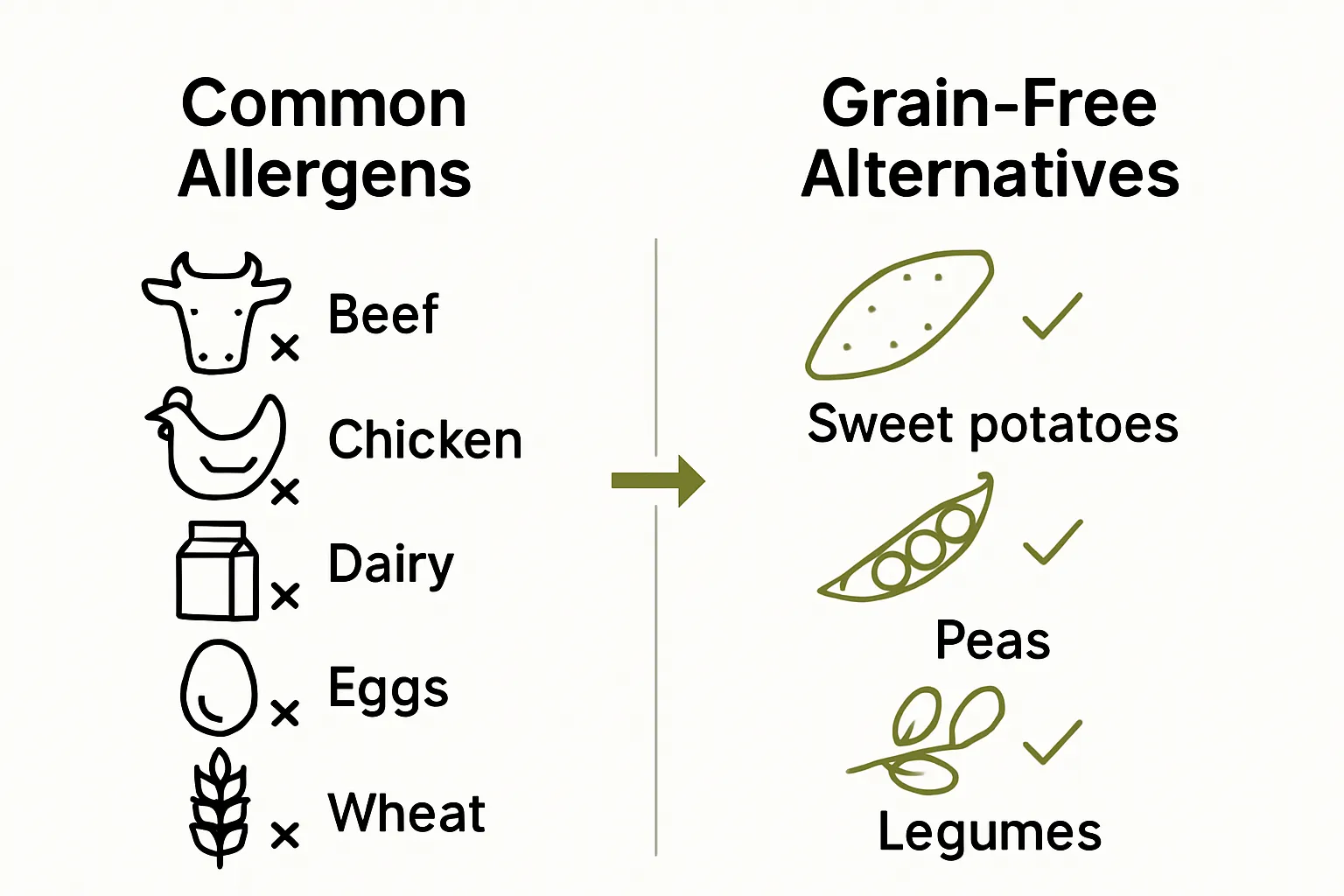
Understanding Dog Food for Allergies: A Comprehensive Guide
Share
Dog food allergies can turn every meal into a guessing game, leaving owners confused about which ingredients are safe. Yet despite endless advice, many are shocked to learn that about 10 to 20 percent of dogs develop a food-related allergic reaction during their lifetime. That number may sound high but skin problems are actually the most common sign, not vomiting or diarrhoea like most people expect.
Table of Contents
- What Causes Food Allergies In Dogs And Why It Matters
- How Dog Food Ingredients Can Affect Allergies
- Recognising Symptoms Of Food Allergies In Your Dog
- The Role Of Grain-Free Diets In Dog Allergy Management
- Choosing The Right Dog Food For Allergies: Key Considerations
Quick Summary
| Takeaway | Explanation |
|---|---|
| Recognise food allergy symptoms early | Early detection of symptoms like itching, infections, and digestive issues improves treatment outcomes. |
| Avoid common allergens in dog food | Proteins like beef, chicken, and dairy are frequent triggers for allergic reactions in dogs. |
| Choose limited ingredient diets | Foods with fewer ingredients help reduce the likelihood of allergic responses in sensitive dogs. |
| Consider grain-free diets carefully | Grain-free options can help eliminate triggers, but monitor for new allergens in alternative sources. |
| Use elimination diet to identify triggers | Temporarily remove potential allergens from the diet to isolate and identify specific sensitivities. |
What Causes Food Allergies in Dogs and Why It Matters
Food allergies in dogs represent a complex immune system response where the body mistakenly identifies specific protein molecules as harmful invaders, triggering an inflammatory reaction. Unlike simple food sensitivities, true allergic responses involve the immune system creating antibodies against certain food components, particularly proteins.
The Immune System’s Overreaction
When a dog develops a food allergy, their immune system becomes hypersensitive to specific protein structures found in their diet. Our comprehensive guide on dog food ingredients explains how certain proteins can provoke this abnormal immune response. The most common allergens typically include:
- Beef
- Chicken
- Dairy products
- Eggs
- Wheat
- Soy
Research from Cornell University College of Veterinary Medicine indicates that approximately 10-20% of dogs experience some form of food-related allergic reaction during their lifetime. This statistic underscores the significance of understanding and managing canine dietary sensitivities.
Genetic and Environmental Factors
Some dogs are genetically predisposed to developing food allergies, with certain breeds like German Shepherds, Retrievers, and Bulldogs showing higher susceptibility. The development of these allergies often involves a combination of genetic predisposition and environmental triggers. Repeated exposure to the same protein sources can gradually sensitise a dog’s immune system, leading to an increasingly pronounced allergic response.
Understanding these mechanisms is crucial for pet owners, as identifying and eliminating problematic ingredients can significantly improve a dog’s overall health and quality of life. Our Freshly Prepared Meat range, gentle cooked at 82°C, ensures that nutrients remain intact while minimising potential allergenic responses through carefully selected, human-grade ingredients.
How Dog Food Ingredients Can Affect Allergies
Dog food ingredients play a pivotal role in triggering or managing food allergies, with protein sources being the primary culprits in most allergic reactions. Understanding the intricate relationship between specific ingredients and immune system responses is crucial for pet owners seeking to support their dog’s nutritional health.
Protein Complexity and Immune Triggers
Proteins are large molecular structures that can easily become recognized as foreign substances by a dog’s immune system. Our comprehensive guide on dog food ingredients highlights how protein molecular complexity determines potential allergenic properties. The more processed or modified a protein becomes, the higher the likelihood of provoking an immune response.
Research from Veterinary Dermatology reveals that certain protein structures are more likely to induce allergic reactions. The most problematic protein sources typically include:
- Beef
- Chicken
- Lamb
- Fish
- Dairy proteins
- Eggs
Ingredient Processing and Molecular Changes
The method of ingredient preparation significantly influences allergenicity. Heat treatment, processing techniques, and ingredient combinations can fundamentally alter protein structures, potentially increasing their allergenic potential. Our Freshly Prepared Meat range, gentle cooked at 82°C, ensures minimal protein structure disruption while maintaining nutritional integrity.
Understanding these molecular interactions allows pet owners to make informed dietary choices. By selecting carefully sourced, minimally processed ingredients and recognizing individual dog’s specific sensitivities, owners can develop nutrition strategies that support optimal health and minimise allergic reactions.
Recognising Symptoms of Food Allergies in Your Dog
Food allergies in dogs manifest through a complex array of symptoms that can often be mistaken for other health conditions. Understanding these signs requires careful observation and a nuanced approach to canine health monitoring.
Skin and Coat Indicators
Skin reactions represent the most prevalent and visible manifestation of food allergies. Our comprehensive guide on dog food for skin issues provides deeper insights into these symptoms. Dogs experiencing food allergies typically demonstrate:
The following table summarises the most common symptoms of food allergies in dogs, helping readers quickly distinguish between skin-related and digestive system indicators.
| Symptom Category | Common Signs in Dogs | Notes on Prevalence/Impact |
|---|---|---|
| Skin and Coat | Persistent itching, recurrent ear infections, hot spots, excessive licking | Skin reactions are the most prevalent, accounting for about 70% of allergies |
| Chewing of paws, recurring rashes or hives | Observing dermatological changes is vital for early detection | |
| Digestive System | Chronic diarrhoea, frequent vomiting, weight loss, reduced appetite | Gastrointestinal disruptions may follow or accompany skin symptoms |
| Excessive gas, bloating | Digestive symptoms often mistaken for non-allergic issues |
- Persistent and intense itching
- Recurrent ear infections
- Hot spots and skin inflammation
- Excessive licking or chewing of paws
- Recurring rashes or hives
Research from VCA Animal Hospitals indicates that approximately 70% of food allergy symptoms initially present through dermatological changes, making skin observations crucial for early detection.
Digestive System Responses
Beyond skin manifestations, food allergies significantly impact a dog’s digestive system. Gastrointestinal symptoms can range from mild discomfort to more severe inflammatory responses. These may include:
- Chronic diarrhoea
- Frequent vomiting
- Unexpected weight loss
- Reduced appetite
- Excessive gas and bloating
Our Freshly Prepared Meat range, gentle cooked at 82°C, provides a nutritionally balanced alternative for dogs with sensitive digestive systems, minimising potential allergic triggers through carefully selected, human-grade ingredients.
The Role of Grain-Free Diets in Dog Allergy Management
Grain-free diets have emerged as a potential solution for dogs experiencing food allergies, offering an alternative nutritional approach that eliminates common grain-based triggers. Understanding the nuanced role of grain-free nutrition requires careful examination of its potential benefits and limitations.
Understanding Grain Sensitivities
Our comprehensive guide on grain-free diet benefits explores the intricate relationship between grains and canine allergic responses. Grains contain complex protein structures that can potentially stimulate immune system reactions, making them a significant consideration for dogs with persistent allergic symptoms.
Research from Veterinary Nutrition suggests that wheat, corn, and barley are among the most common grain-based allergens that can trigger inflammatory responses in sensitive dogs. Potential grain-related allergic indicators include:

- Persistent skin irritations
- Digestive system disruptions
- Chronic ear infections
- Unexplained weight fluctuations
- Reduced energy levels
Alternative Protein and Carbohydrate Sources
Grain-free diets typically replace traditional grains with alternative carbohydrate sources such as sweet potatoes, peas, and legumes.
This table presents a comparison of common protein and grain allergens in dog food and the alternative ingredients often used in allergy-friendly diets.
| Allergen Category | Frequent Triggers | Alternative Ingredients in Allergy Management |
|---|---|---|
| Animal Proteins | Beef, chicken, lamb, fish, eggs | Single-source novel proteins (venison, duck), insect protein |
| Dairy | Dairy proteins | Lactose-free or dairy-free recipes |
| Grains | Wheat, corn, barley | Sweet potatoes, peas, legumes, grain-free carbohydrate blend |
| Soy | Soy | Legume alternatives, grain-free options |
Choosing the Right Dog Food for Allergies: Key Considerations
Selecting an appropriate dog food for dogs with allergies requires a strategic approach that considers multiple nutritional and health factors. The goal is to identify a diet that supports overall health while minimising potential allergenic triggers.
Ingredient Quality and Complexity
Our comprehensive guide on food for sensitive dogs highlights the critical importance of ingredient sourcing and processing. When managing canine food allergies, pet owners should prioritise foods with:
- Limited ingredient profiles
- Single protein sources
- Minimal processing
- Human-grade ingredient standards
- Transparent sourcing information
Research from Journal of Veterinary Dermatology suggests that simplified ingredient lists can significantly reduce the risk of triggering allergic responses, making careful ingredient selection paramount.

Elimination Diet Strategy
Veterinarians often recommend an elimination diet approach to pinpoint specific allergens. This methodical process involves temporarily removing all potential trigger ingredients and systematically reintroducing them to identify precise sensitivities. Our Freshly Prepared Meat range, gentle cooked at 82°C, provides an ideal foundation for such dietary investigations, offering carefully selected, minimally processed proteins that support comprehensive nutritional needs while facilitating precise allergy identification.
Help Your Dog Thrive With Allergy-Friendly Nutrition
Does your dog struggle with itching, digestive upsets or stubborn skin issues due to food allergies? Making the right choice for your dog’s nutrition can feel overwhelming when you need to avoid common triggers, manage sensitivities and keep your pet comfortable. Our article covers how food ingredients and preparation impact allergies, highlighting the importance of high-quality protein sources, gentle processing and grain-free recipes for dogs with special dietary needs. With this knowledge, you can take action and choose food crafted to help your dog live their best life.
Discover our Dry Dog Food | Grain-Free & Science-Backed Kibble for pure, hypoallergenic recipes that support sensitive stomachs and healthy skin.

Ready to put an end to guesswork and give your pet a diet tailored for allergies? Explore the full range of grain-free options at Ultimate Pet Foods. You will find solutions built on science and nature so your dog can enjoy relief, vitality and fresh ingredients in every bowl. Shop now to make a visible difference in your dog’s wellbeing.
Frequently Asked Questions
What are the common symptoms of food allergies in dogs?
Food allergies in dogs often manifest through skin and coat issues such as persistent itching, hot spots, and recurrent ear infections. Gastrointestinal symptoms like chronic diarrhoea, vomiting, and unexpected weight loss can also indicate food allergies.
How can I identify the allergens in my dog’s diet?
An effective way to identify allergens is by following an elimination diet strategy. This involves removing all potential trigger ingredients from your dog’s diet and then reintroducing them one at a time to observe for any allergic reactions.
What role do protein sources play in dog food allergies?
Protein sources are the primary culprits in most dog food allergies. The immune system can mistakenly identify specific proteins as harmful, triggering inflammatory responses. Common allergenic proteins include beef, chicken, dairy, and eggs.
Are grain-free diets beneficial for dogs with food allergies?
Grain-free diets can be beneficial for dogs with food allergies, as they eliminate common grain-based allergens like wheat and corn. They often replace grains with alternative carbohydrate sources that are less likely to trigger allergies, such as sweet potatoes and peas.
Recommended
- Understanding the Best Dog Food for Sensitive Dogs – Ultimate Pet Foods
- Master the Elimination Diet for Dogs: A Complete Guide – Ultimate Pet Foods
- What Ingredients to Avoid in Dog Food for Healthier Pups – Ultimate Pet Foods
- Understanding Single Protein Dog Foods: A Comprehensive Guide – Ultimate Pet Foods
- Eliminatiedieet hond: Verbeter de gezondheid van uw huisdier - Mijn Voedsel Intolerantie Test
